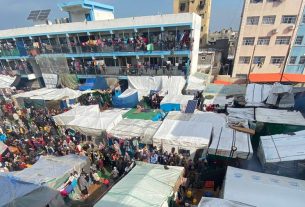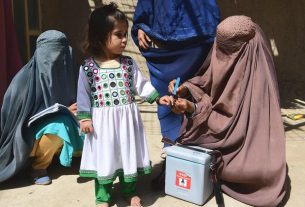(Washington, DC) – Ecuadorian police and security forces have restricted freedom of assembly and at times used excessive force in their response to anti-government protests since mid-September, 2025, Human Rights Watch said today.
Since September 18, the country’s largest Indigenous organization has led protests following President Daniel Noboa’s decision to scrap diesel fuel subsidies. While some protesters have engaged in violence, most demonstrations have been peaceful. The government responded by deploying the military, which has used excessive force against protesters on several occasions. The government accused protesters of “terrorism” and froze the bank accounts of environmental and Indigenous groups and leaders.
“The Ecuadorian government should respect the rights of protesters and respond to the grievances that periodically bring Ecuadorians to the streets,” said Juanita Goebertus, Americas director at Human Rights Watch. “Protesters who engage in violence should be investigated, but that does not justify stigmatizing other demonstrators or using excessive force.”
Human Rights Watch verified 15 videos of protests, showing soldiers or police officers forcibly dispersing peaceful demonstrations and using tear gas and other “less lethal” weapons recklessly and indiscriminately. Researchers also reviewed official documents suspending a media outlet and opening investigations against environmental defenders and Indigenous people. They also sought comment from the Ministries of Interior and Defense regarding allegations of excessive force and protest-related deaths.
On September 12, President Noboa eliminated the country’s longstanding diesel subsidy, raising fuel prices by over 50 percent. He said that the subsidy cost the government nearly US$1.1 billion annually and undermines the “sustainability of public finances.” Mirroring protest movements of past years, various organizations and workers immediately announced demonstrations in response to the decision.
On September 16, President Noboa issued a presidential decree declaring a state of emergency in 7 of the country’s 24 provinces, citing “serious internal unrest” caused by protesters blocking roads. The decree suspended the right to freedom of assembly and triggered deployment of the armed forces. Although the Constitutional Court later limited the measure to two provinces, President Noboa issued a new decree on October 4 covering 10 additional provinces. The court has yet to review it.
Since January 2024, President Noboa has repeatedly relied on states of emergency to deploy the military to Ecuador’s streets and prisons, which has led to increased reports of human rights violations. He also declared that the country is experiencing an “internal armed conflict” in an effort to justify wider and potentially more lethal use of military forces, which the Constitutional Court has called into question.
On September 18, the Confederation of Indigenous Nationalities of Ecuador and other Indigenous movements announced a national strike in response to the diesel subsidy cut, poor access to health care and education, and oil extraction on Indigenous land. Demonstrations have spread nationwide, evolving into broader anti-government protests.
Some protesters have engaged in acts of violence, including damage to public and private property. In September, Indigenous people held 17 soldiers for three days. The government also reported two attacks on official convoys carrying the president. In an email sent to Human Rights Watch on October 17, the acting minister of defense cited “lethal aggressions” against soldiers and cases of “kidnappings [and] torture.”
As of October 18, the Alliance for Human Rights in Ecuador, a coalition of human rights groups, had received 377 reports of human rights violations during the protests, resulting in at least 296 people injured and two deaths.
In one video Human Rights Watch verified, security forces near the Huaycopungo community in Imbabura province are seen firing tear gas canisters at a low trajectory at houses with apparently no crowds present. Tear gas should always be launched in an arc toward open areas, and force should only be used when necessary to achieve a legitimate objective.
Another video in Otavalo shows a security officer firing projectiles from a projectile launcher at close range directly at a protester as he flees. It is not possible to identify the type of projectile used. Using less lethal weapons that way is not justifiable under international human rights standards and creates a risk of serious harm.
Efraín Fueres died at the protests in Cotacachi, Imbabura province on September 28. Human Rights Watch verified three videos shared on social media showing a person human rights organizations, media outlets, and community members said is Fueres. One video, filmed by a static CCTV camera and posted to X, shows Fueres being carried by a group of four people amid dozens of people fleeing what appears to be tear gas.
The people carrying Fueres leave him on the ground and three flee as armored vehicles approach. A person in a blue shirt remains with Fueres. Another returns and appears to carry out hands-only cardiopulmonary resuscitation, then flees again.
The armored vehicles return and five people in military uniforms get out and beat Fueres and the other man for several minutes. One security force member fires tear gas. The soldiers then leave, and protesters eventually carry Fueres away.
The human rights organization Fundación Regional de Asesoría en Derechos Humanos, known as INREDH, reported that Fueres died from a gunshot wound to the back that damaged his lung. The Attorney General’s Office has opened an investigation into the apparent illegitimate use of force that caused Fueres’s death.
The Alliance for Human Rights also reported that at least 205 people were detained. Some protesters have been charged with terrorism.
The government has also taken steps to undermine the freedom of expression and association of Indigenous organizations and environmental groups, Human Rights Watch said.
On September 22, the telecommunications regulatory agency suspended UHF Channel 47, operated by the community media outlet Indigenous and Peasant Movement of Cotopaxi (TV MICC), for 15 days. The decision, which Human Rights Watch reviewed, cites a “secret” report indicating that the media outlet supposedly “harm[ed] national security.” Two other community media outlets reported that they have been temporarily suspended under similar circumstances.
Since September 19, the authorities have frozen bank accounts of Indigenous and environmental organizations and leaders, reportedly on the basis of “secret” intelligence reports. The Ministry of Interior alleged that the groups had funded violent protests. A new Social Transparency Law imposes greater oversight on nongovernmental organizations and allows authorities to freeze their bank accounts without a court order. Under the law, the government can also dissolve organizations that commit “grave” infractions, such as carrying out various unauthorized activities.
On September 25, the Attorney General’s Office opened an investigation into the “unjustified private enrichment” of over 50 people, including the president of the Confederation of Indigenous Nationalities of Ecuador and members of environmental organizations, such as Pachamama and Yasunidos.
“The Ecuadorian government should ensure accountability for abuses and recognize the importance of the issues protesters are raising in the streets,” Goebertus said.


